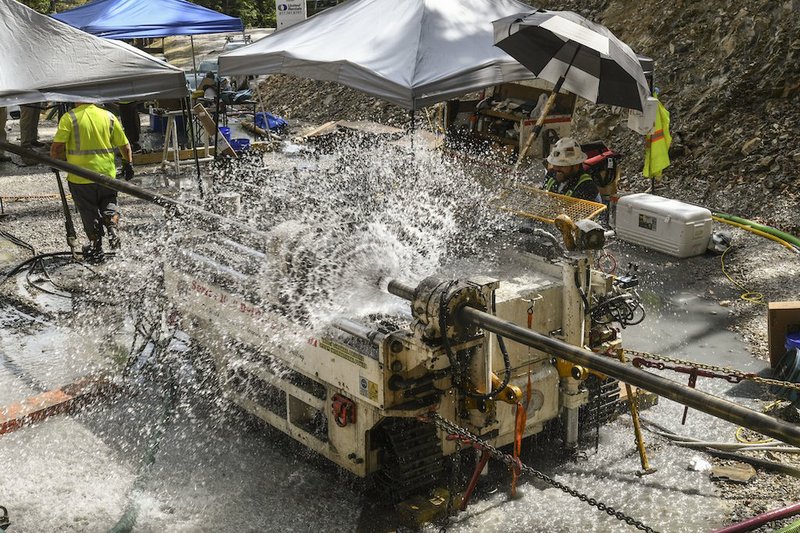EDITOR'S NOTE: This is the final installment of a two-part series on the more than $100 million in capital improvements the city is making to the regional water system.
MOUNTAIN PINE -- The exploration into Blakely Mountain has begun, 10 feet at a time.
That's the length of the 2-inch core samples the crew from REI Drilling of Salt Lake City has been extracting since the end of last month. The composition of those samples will determine if a tunnel boring machine can hollow out a 5-foot diameter corridor from the base of the mountain's southern slope to an inlet east of Lake Ouachita's main channel.
The roughly half-mile path 300 feet under the mountain would allow lake water to gravity flow to the treatment plant the city of Hot Springs plans to build almost 20 miles to the south near Amity Road. An easement recorded earlier this month showed the city acquired a critical stretch of right of way for the raw water line, securing a 20-foot path across a 90-acre Weyerhaeuser parcel south of the mountain.
"It's a beautiful situation for us," Hot Springs Utilities Director Monty Ledbetter said. "With a gravity feed to the treatment plant we don't have to pump. No energy is required. It's all downhill."
The drillers were 185 feet into the mountain last week, drilling into U.S. Forest Service land. They have encountered mostly black shale, sandstone and groundwater. Hydrostatic pressure from the latter had slowed the progress of the drilling rig's diamond-tipped bit.

"The water is flowing pretty good right now," James Goldsberry, an engineering geologist with Aldea Services Inc. said as water gushed from the wellhead. "The other day we had inflows of about 60 gallons a minute. Now it's about in the 70 to 90 range. The water is under about 30 pound per square inch of pressure.
"The other night it was coming out at about 60 gallons a minute. It came down to about 5 then we hit another seam and it went up to 7o or 90. Right now (the drillers) are fighting water. It's slowing things down big time."
Goldsberry said pathways for water to move underground are a common feature of area geology.
"The bedrock around here is very folded," he said. "There's a lot of anticlines and synclines. The water in the bedrock travels through fractures and joints."

Goldsberry and Archana Gopakumar, a tunnel engineer with Aldea Services, are collecting and labeling the core samples, denoting from how far into the mountain each sample segment was extracted. Most of the more than 2,000 feet of samples will be stored, allowing contractors that bid on the micro-tunneling project to determine what equipment will be needed to cut through the mountain.
Some samples will go to a lab in Boston for further analysis.
"They'll test its strength and abrasive properties," Goldsberry said. "(The drilling contractor) is going to design their (tunnel boring machine) cutter teeth based on how abrasive it is. If you don't figure out how abrasive it is you're going to have issues with the cutter teeth wearing out and having to go in and remove them, which is difficult to do and takes time."
He said quartz grains in sandstone segments REI has extracted are significantly harder than the black shale segments taken from the mountain. Lab analysis will determine the shale's propensity for slaking, or turning to clay with exposure to water and air.
"Some shales don't slake at all," he said. "We call those more rocklike. Ones that slake we call them more clay-like."

Aldea and REI were subcontracted for the horizontal boring work by Crist Engineers Inc., the Little Rock firm the Hot Springs Board of Directors awarded a $5.26 million contract to design and oversee the $100 million Lake Ouachita Water Supply Project.
The project's first construction contract was awarded to Township Builders, which won the $159,080 job to clear and build a 1,000-foot temporary road to the drill site across U.S. Army Corps of Engineers and USFS property. The wellhead location will eventually be where the micro-tunnel connects to the raw water line.
The city said the state Department of Health is requiring a pump station be built at the connection. Pumps could pressurize the raw waterline if the lake level drops and reduces the hydraulic energy of water coming through the intake structure.
The main intake port will be around 555 feet above sea level, the city said, more than 20 feet below the lake's normal pool elevation. Ports at 545 and 535 feet should also be available.
"We don't need pumps, but the Health Department makes us have pumps," Ledbetter said. "We can gravity feed from here to our treatment plant, so actually we'll be bypassing those pumps all the time."
Ledbetter said the cove where the intake will be built is tailor-made for the project. Located above Blakely Mountain Dam and inside a larger inlet east of the main channel, the cove is about 100 yards across at its widest point.
"It's a deep pocket that's perfectly made for us," he said. "It's about 80 feet deep in that pocket, and the bottom is really clean."
Local on 09/22/2019
